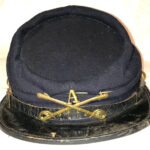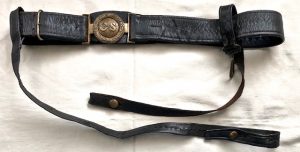Confederate 32 lb. Solid Shot Excavated at Ft. Clifton on the Appomattox River North of Petersburg
SOLD
Confederate 32 lb. Solid Shot Excavated at Ft. Clifton on the Appomattox River North of Petersburg – We recently obtained a large collection of excavated artifacts from a long time relic hunter who searched primarily in Amelia County, Virginia and in the Petersburg area, in the late 60s to the mid-70s; he hunted along the retreat route and around the Sailor’s Creek battlefield, as well. Amongst the varied array of artifacts he excavated was this Confederate 32 lb solid shot which was dug in or near the Confederate, Appomattox River Ft. Clifton, now a city park in Colonial Heights, just north of Petersburg, Virginia. The fort, designed by famed Confederate engineer, Capt. Charles H. Dimmock, was completed in early 1864, was erected to guard against Union incursions up the Appomattox; it was bombarded by Union forces and under constant fire, during the course of the Siege of Petersburg. Ft. Clifton was abandoned when Petersburg fell, on April 2, 1865.
This large solid shot remains in excellent, dug condition, with virtually no major oxidation or flaking; the typical Confederate mold seam is visible on this projectile.
From a website hosted by the City of Colonial Heights, location of Ft. Clifton:
Fort Clifton
History
Fort Clifton was a Confederate stronghold on the Appomattox River, serving as an important link in the line that defended Richmond and Petersburg in 1864 and 1865. Located on a high bluff at the junction of the Appomattox River and Swift Creek, the fort controlled navigation on the river north of Petersburg and was a formidable defensive bastion that wasn’t taken by Union forces until the fall of Petersburg on April 3, 1865. The three earthworks that comprised the fort’s batteries still stand on the bluffs along the river.
Artillerists and militiamen garrisoned the position in 1862, and the fortifications were completed early in 1864. A powder magazine, guardhouse and prison stockade, hospital, and even a “ladies quarters” stood inside the fort, while underground huts were “built into ravines and gullies” around it. Rifle pits – running northwest toward a six-gun battery on Swift Creek – protected the fort’s flanks from infantry assault and are readily visible behind the main earthworks today.
In May 1864, Fort Clifton withstood five Union sorties up the Appomattox River. The most serious came on May 9, during the Bermuda Hundred campaign. Union gunboats commanded by Gen. Charles K. Graham bombarded the fort while Federal forces probed Confederate defenses on both sides of the river. During this attack, the gunboat Samuel L. Brewster was disabled by Confederate fire and scuttled.
As the 10-month siege of Petersburg progressed, the men were constantly exposed to the fire of Federal pickets and artillery on the opposite bank of the river. Fort Clifton was evacuated April 2, 1865. A detail spiked its 14 guns and blew up the powder magazine. A week later, members of Fort Clifton’s garrison surrendered with the remnants of the Army of Northern Virginia at Appomattox Court House.
Fort Clifton Archeological Site is a historic American Civil War fort archaeological site located at Fort Clifton Park, Colonial Heights, Virginia. The park is the site of Fort Clifton on the Appomattox River where five Union ships sailed on Confederate troops on June 11, 1864. The Confederate Battery, with cannon emplacements, remained in Confederate hands as the cannons drove the Union attackers away. The park has earthworks that criss-cross the property. Fort Clifton Park has hiking trails and Civil War campaign signage on site.
It was listed on the National Register of Historic Places in 1981.





























